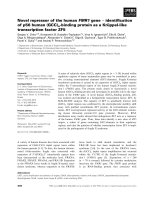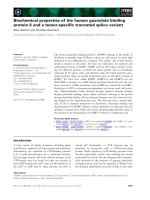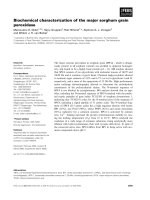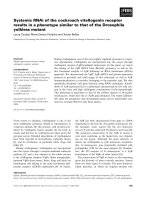báo cáo khoa học: " Laparoscopic resection of a lymphangiomatous cyst of the colon: a case report" ppt
Bạn đang xem bản rút gọn của tài liệu. Xem và tải ngay bản đầy đủ của tài liệu tại đây (1.56 MB, 4 trang )
CAS E REP O R T Open Access
Laparoscopic resection of a lymphangiomatous
cyst of the colon: a case report
Jonas Hoffmann
1
, Andreas Kirschniak
1
, Gregor Scharf
2
, Maximilian von Feilitzsch
1
, Alfred Königsrainer
1
and
Marty Zdichavsky
1*
Abstract
Introduction: Lymphangiomatous cysts are submucosal masses that are ra rely found in the gastrointestinal tract
and more often in the neck, oral cavity, and skin. These cysts are benign tumors and mostly clinically silent.
Symptoms include abdominal pain, diarrhea, and rectal bleeding. Their pathogenesis remains unclear.
Case presentation: During a routine ultrasound examination of a Caucasian 25-year-old woman, a structure that
raised our suspicions of an ovarian cyst was found. MRI showed a 4.5 cm cystic lesion in the cecal region.
Laparoscopic exploration revealed unexpected contact with the ascending colon. The cyst, including its ba se and
of portion of the colon, was resected laparoscopically. The histological examination revealed cystic lymphangioma.
Conclusion: Lymphangiomatous cysts of the colon are very rare lesions. Although their pathology is benign, the
recommended treatment is resection, which can be performed with minimal invasiveness.
Introduction
Benign cystic lymphangiomas are rare intra-abdominal
lesions that may be asymptomatic or may mimic a vari-
ety of abdominal symptoms, including an acute abdo-
men. The gastrointestinal tract, including the
involvement of the colon, is an unusual location to find
these cysts. Although of benign character, cystic lym-
phangiomas should be removed surgically to prevent
further complications and malignancy. This case report
concerns a very rare case of an unexpected cystic lym-
phangioma of the colon that was resected during mini-
mally invasive surgery.
Case presentation
We found a cystic structure in a Caucasian 25-year-old
woman incidentally during an ultrasound examination.
Our primary clinical suspicions were that it was an
ovarian cyst. She had no history of abdominal disease.
The lesion was localized in the right lower quadrant.
In a control examination a few months later, the finding
was descri bed as an extraluminal cystic, septic structur e
underneath the cecum and in a lateral position in
relation to the iliac vessels. For further differentiation,
MRI was performed, which revealed a 4.5 cm cystic
lesion in the cecal region (Figure 1).
The patient’s blood chemistry was unremarkable. The
indication was for surgical resection because of the size
of the cyst, but resection carried the risk of potential
comp lications. However, surgical resect ion was the wish
of the patient. Lapa roscopic exploration showed contact
of the cyst to the ascending colon (Figures 2 and 3).
The whole cyst, including its base and an adjacent part
of the colon, was resected (Figure 4) using the Multifire
Endo GIA™ 45 Stapler (Covidien Deutschland GmbH,
Sugical, Gewerbepark 1, 93333 Neustadt/Donau, Ger-
many). The staple line was subsequently oversewn
manually.
The histopathological examination of the cyst showed
a 3.5 cm × 2.7 cm fluid-filled cystic jelly structure with
serous content (Figure 5) and a smooth endothelial layer
(Figure 6). The mass was soft and green. Focally, aggre-
gates of lymphocytes were found. The diagnosis of a
lymphangiomatous cyst was made.
The patient’s recovery was fast and uneventful. Peri-
staltic activity appeared on day 1 post-operatively, and
the patient was discharged within two days after surgery.
At her follow-up examination one year after surgery, the
patient was symptom-free without recurrence.
* Correspondence:
1
Department of General, Visceral and Transplant Surgery, University Hospital
Tübingen, Hoppe-Seyler-Strasse 3, D-72076 Tübingen, Germany
Full list of author information is available at the end of the article
Hoffmann et al. Journal of Medical Case Reports 2011, 5:431
/>JOURNAL OF MEDICAL
CASE REPORTS
© 2011 Hoffmann et al; licensee BioMed Central L td. This is an Open Acces s article distributed under the terms of the Creative
Commons Attribution License ( which permits unrestricted use, distribution, and
reproduction in any medium, provided the original work is properly cited.
Discussion
The presence of lymphangiomas in the colon is rare. In
1931, Chisholm and Hillkowitz [1] reported the first
case of colonic lymphangioma published in the litera-
ture. The incidence of these lymphatic cysts is thought
to range between 1 in 100,000 and 1 in 250,000 hospital
admissions worldwide. Other authors found a report of
one lymphatic cyst of the colon in a review spanning 10
years and comprising 453,708 gastrointestinal radio-
graphic studies [2]. Geboes et al. [3] reported one case
of a cecal lymphatic cyst in a review of 25 cases of sub-
mucosal lesions.
There is no difference between men and women with
regard to the i ncidence of these lesions. In Japan, the
incidence of colonic lymphatic cysts appears to be
higher than in American and European populations.
Colonic lymphangiomas in particular, such as that
reported in our case, have a peak incidence in the
seventh decade of life [4].
The etiology of lymphangiomas remains unclear. As
most cases occur during childhood [5], generally in
patients younger than two years of age, congenital
defects such as the proliferation and dilatation of blind-
ended lymphatic sacs have been discussed [6]. Other
causes that have been proposed include abdominal
trauma, localized lymphatic degeneratio n, and lymphatic
obstruction. Some authors have postulated that lym-
phangiomas are not true neoplasms but hamartomas
[7,8]. It has been shown that these lesions do not predis-
pose patients to malignancy.
Lymphatic cysts show an equal distribution through-
out the colon; however, other parts of the body are
more often involved. The most frequent localizations
aretheneck(75%)andtheaxilla(20%).Withinthe
abdomen, the most common site is the mesentery [6].
Figure 1 MRI scan showing the cystic lesion in the cecal region
(arrow).
Figure 2 Connection to the colon.
Figure 3 Intra-operative appearance of the cyst.
Figure 4 Resection was performed using the Multifire Endo
GIA™ 45 Stapler.
Hoffmann et al. Journal of Medical Case Reports 2011, 5:431
/>Page 2 of 4
Other possible locations include the omentum, retroper-
itoneum, mesocolon, pancreas, spleen, and adrenal
gland [9-12]. Cases of lymphangiomas involving two
organs are extremely rare.
In the largest recent review of patients with lymphatic
cysts, a high percentage of the patients showed co-exis-
tent lesions. Colorectal carcinomas were found in 7% of
the patients, colonic adenomas were found in 16% of
the patients [13].
The possible clinical manifestations include abdominal
distensio n, abdominal pain, loss of appeti te, nausea, and
vomiting. Furthermore, melena and diarrhea are poten-
tial symptoms.
The most freq uen t classification system used for lym-
phangiomas is still that of Wegner [14], who categorized
them as simple, cavernous, or cystic.
Because of their mainly asymptomatic character,
lymphatic cysts are usually found mostly by accident.
Fewer cases are found by examination and manage-
ment of their complications, which include torsion,
rupture, intestinal occlusion, and obstruction of
nearby organs. Some cases of cysts mimicking other
diseases, such as ovarian cysts, pancreatitis, lipomas,
adnexal torsion, volvulus, and congenital duplication
of the bowel have also been reported. Prakash et al.
[15] reported a series of cases in children younger
than 10 years of age with acute or chronic symptoms
due to mesenteric lymphangiomatous cysts. Five of
these children were found to have volvulus on
exploration.
Natural regression is very unlikely. Treatment options
include endoscopic removal for intraluminal lesions
smaller than 2 cm and surgical resection for larger
lesions. This could be radical, segmental or wedge resec-
tion. The risk of developing divert icular formations
caused by weakening of the bowel wall is higher in
patients who und ergo wedge resection. Surgical excision
needs to be as complete as possible to reduce the risk of
recurrence.
The first case of laparoscopic excision of a cystic
lymphangioma was reported in 1996 by Kenney et al.
[16]. This patient’s cyst was localized in the mesentery
of the proximal jejunum. L aparoscopic resection of
lymphatic cysts has been performed to remove cysts of
the lower omentum and cysts larger than 11 cm [17].
Even when lymphatic cysts are asymptomatic and dis-
covered accidentally, they should be treated surgically
because of their potential to grow and cause hazardous
complications.
Conclusion
Lymphangiomatous cysts of the colon are very rare
lesions that have been reported with increased frequency
in recent years as a result of the development and wide-
spread use of colonoscopy. Although these cysts are
benign, resection is essential to prevent complications
and to definitively exclude malignancy.
Consent
Written informed consent was obtained from the patient
for publication of this case report and any accompany-
ing images. A copy of the written consent is available
for review by the Editor-in-Chief of this journal.
Figure 5 Low-magnification image showing the cyst with
serous content.
Figure 6 High-magnification image of the endothelial layer.
Hoffmann et al. Journal of Medical Case Reports 2011, 5:431
/>Page 3 of 4
Author details
1
Department of General, Visceral and Transplant Surgery, University Hospital
Tübingen, Hoppe-Seyler-Strasse 3, D-72076 Tübingen, Germany.
2
Department
of Pathology and Forensic Medicine, University Hospital Tübingen, Tübingen,
Germany.
Authors’ contributions
JH drafted and conceived of the manuscript. AK assisted in the drafting of
the manuscript, edited the final version of the manuscript, and reviewed the
literature. GS made the histopathological diagnosis. MVF made critical
revisions to the manuscript. MZ performed the operation and was involved
in the drafting and editing of the manuscript. All authors read and approved
the final manuscript.
Competing interests
The authors declare that they have no competing interests.
Received: 2 February 2011 Accepted: 5 September 2011
Published: 5 September 2011
References
1. Chisholm AJ, Hillkowitz P: Lymphangioma of the rectum. Am J Surg 1932.
2. Fleming MP, Carlson HC: Submucosal lymphatic cysts of the
gastrointestinal tract; a rare cause of submucosal mass lesion. Am J
Roentgenol 1970, 110:842-845.
3. Geboes K, De Wolf-Peeters C, Rutgeerts P, Vantrappen G, Desmet V:
Submucosal tumors of the colon: experience with twenty-five cases. Dis
Col Rectum 1978, 21:420-425.
4. Young TH, Ho AS, Tang HS, Hsu CT, Lee HS, Chao YC: Cystic
lymphangioma of the transverse colon: report of a case and review of
the literature. Abdom Imaging 1996, 21:415-417.
5. de Perrot M, Rostan O, Morel P, Le Coultre C: Abdominal lymphangioma
in adults and children. Br J Surg 1998, 85:395-397.
6. Weeda VB, Booij KAC, Aronson DC: Mesenteric cystic lymphangioma: a
congenital and an acquired anomaly? Two cases and a review of the
literature. J Pediatr Surg 2008, 43:1206-1208.
7. Willis R: The Borderland of Embryology & Pathology Butterworth Medical
Publications; 1958.
8. Alvich JP, Lepow HI: Cystic lymphangioma of hepatic flexure of colon:
report of a case. Ann Surg 1960, 152:880-884.
9. Chien HP, Chang YS, Hsu PS, Lin JD, Wu YC, Chang HL, Chuang CK,
Tsuei KH, Hsueh C: Adrenal cystic lesions: a clinicopathological analysis of
25 cases with proposed histogenesis and review of the literature. Endocr
Pathol 2008, 19:274-281.
10. Hoeffel CC, Kamoun J, Aubert JP, Chelle C, Hoeffel JC, Claudon M: Bilateral
cystic lymphangioma of the adrenal gland. South Med J 1999, 92:424-427.
11. Abdel-Wahab M, Abou-Elenin A, Sultan A, El-Ghawalpy N, Ezzat F:
Lymphangiomatous cysts of the spleen: report of 3 cases and review of
the literature. Hepatogastroenterology 1998, 45:2101-2104.
12. Egawa S, Satoh T, Suyama K, Uchida T, Iwabuchi K, Koshiba K: Giant
retroperitoneal cyst in an adult male. Int J Urol 1996, 3:304-306.
13. Matsumoto T, Iida M, Kohrogi N, Tada S, Kuwano Y, Yao T, Fujishima M:
Minute nonpolypoid adenomas of the colon depicted with barium
enema examination. Radiology 1993, 187:377-380.
14. Wegner G: Über Lymphangiome. Arch Klin Chir 1877, 20:641-707.
15. Prakash A, Agrawal A, Gupta RK, Sanghvi B, Parelkar S: Early management
of mesenteric cyst prevents catastrophes: a single centre analysis of 17
cases. Afr J Paediatr Surg 2010, 7:140-143.
16. Kenney B, Smith B, Bensoussan AL: Laparoscopic excision of a cystic
lymphangioma. J Laparoendosc Surg 1996, 6(Suppl 1):S99-S101.
17. Ryu WS, Kwak JM, Seo UH, Kim SH, Park SS, Kim CS, Lee CH, Mok YJ:
Laparoscopic treatment of a huge cystic lymphangioma: partial
aspiration technique with a spinal needle. J Laparoendosc Adv Surg Tech A
2008, 18:603-605.
doi:10.1186/1752-1947-5-431
Cite this article as: Hoffmann et al.: Laparoscopic resection of a
lymphangiomatous cyst of the colon: a case report. Journal of Medical
Case Reports 2011 5:431.
Submit your next manuscript to BioMed Central
and take full advantage of:
• Convenient online submission
• Thorough peer review
• No space constraints or color figure charges
• Immediate publication on acceptance
• Inclusion in PubMed, CAS, Scopus and Google Scholar
• Research which is freely available for redistribution
Submit your manuscript at
www.biomedcentral.com/submit
Hoffmann et al. Journal of Medical Case Reports 2011, 5:431
/>Page 4 of 4









